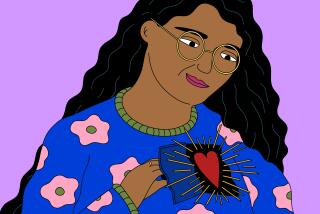Whaddya mean by that look?
- Share via
He smiled when he saw the house. “He likes it,” she thought. Then the smile faded, and a string of other thoughts flitted through her mind. “Oh, he thinks it’s too modern.” “Maybe he hates this part of town.” “This is awful. We never agree.” “The relationship isn’t working.”
Such reactions -- triggered by a simple change of expression -- might seem bizarre to the secure and well-adjusted. But over-interpretation of a slight shift in expression can be all too familiar to the hypersensitive.
Highly anxious people read others’ facial expressions faster than less anxious people, a new study has found.
But they are also more likely to misread them.
“It’s as if they have the skills to judge others’ emotional state accurately,” said R. Chris Fraley, a professor of psychology at the University of Illinois at Urbana-Champaign, and a co-author of the study.
“But they do it so quickly that they actually end up getting it wrong.”
The errors then can create problems of their own, creating conflict when none originally existed.
Although the research was designed to assess how attachment styles affect how people perceive emotional clues, it also suggests that highly anxious people overall may react similarly. The report appears in the August issue of the Journal of Personality.
Participants first filled out an online questionnaire designed to evaluate how anxious they were about their emotional relationship between themselves as infants and their caregivers -- a concept known as attachment. Infants who do not bond well can turn into anxious adults, psychologists say, and Fraley was especially interested in how that can affect their ability to read emotional cues.
In four separate studies, participants were asked to view movies in which an actor’s face morphs from an expression of happiness, sadness or anger to a neutral one, or vice versa.
The researchers found that adults who were highly anxious were quicker than more secure adults to detect the point at which the actor was no longer expressing the original emotion and to say they detected emotional change before it had actually happened. But when forced to be more deliberative, they were also more likely to read the emotional cues correctly.
“If you put highly anxious people in a situation where they can’t make a judgment quickly,” Fraley said, “they are more likely to get it right.”
In other words, anxious people have the innate empathy to read others’ emotions, they just need to remember not to jump to conclusions.
Dr. Alexander Bystritsky, director of the UCLA Anxiety Disorders Program, said anxious people do indeed have a sensitive emotional barometer, allowing them to detect subtle changes in emotion. This barometer can cause them to read too much into an expression or to misinterpret it.
But he pointed out that there are many ways to interpret the data, which were obtained from self-assessments on a website.
“The question is,” Bystritsky said, “is this [misreading] because they have increased sensitivity, or because they have a tendency to invent what is a possible scenario?”
Jerome Kagan, a Harvard psychology professor who has studied the cognitive and emotional development of a child during the first decade of life, said he was “dubious” that researchers could measure a sensitive, complicated concept such as “anxious attachment” through a questionnaire on a website.
“It is unlikely that the adults in this study could remember what happened to them in the first two years of life,” he said. “In my opinion, this study implies that a small number of adults who admit on a website that they experience anxiety and uncertainty are motivated to avoid making a mistake,” he added in an e-mail.
“Hence they say the face changed a little sooner in order to protect themselves against waiting too long and being incorrect.”
But others found the research provocative. Helen Resneck-Sannes, a Santa Cruz psychologist in private practice who has written on the neurobiology of attachment, said she thought the researchers needed a few more control groups, including a group that is simply anxious, because anxious people may just be more hyper-vigilant.
But she added that she thought the study offered “a good paradigm for studying people’s reactions to facial expressions.”
“This opened up an entire area for psychologists to begin studying,” she said.
“I thought what they did was very creative.”
Fraley agrees more research is necessary but thinks his studies could potentially help anxious people make better sense of their relationships.
“It might allow us to understand why it is some relationship partners don’t really understand where their significant others are coming from,” Fraley said. “If they are insecure, it might be that they are trying to gauge our true motivations and feelings prematurely, leading to misunderstandings.”
That, he said, might in turn allow arguments to escalate.
Highly anxious people appear to have the skills that allow them to make these inferences accurately, he said. “The challenge is to discover how to make that happen in everyday life.”





